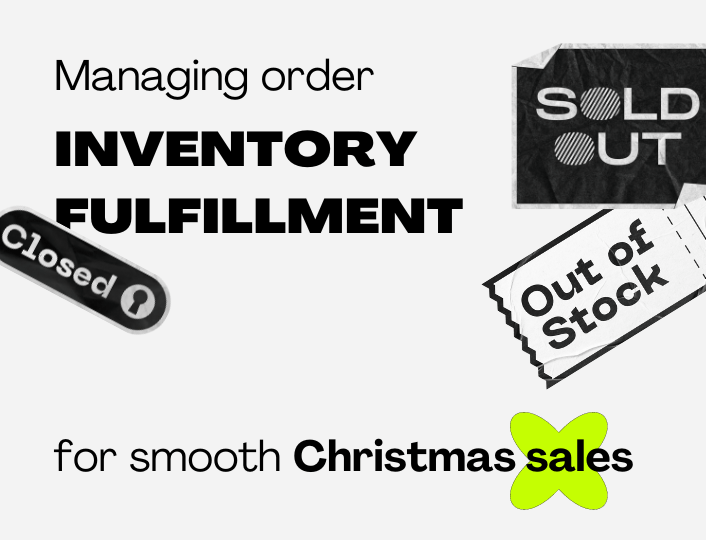Imagine you run out of stock the day before Christmas, or finding out your best-selling outfit just got sold out on New Year’s Eve. That’s what happens when you don’t manage order inventory prior to and during Christmas sales.
Missing out on these sale opportunities not only affects your overall profit, but also leaves an unsatisfying taste on your customers’ tongues.
The surefire way to avoid stock-out problems during Christmas is to plan and manage your inventory properly.
In this post, we’ll explore the best strategies to manage your order inventory and fulfillment and how you can make the most of the holiday season.
8 Best Strategies to Manage Christmas Order Inventory and Fulfillment
In 2022, consumers spent a total of $1.14 trillion online globally and $270 billion in the U.S – an exciting time for retailers to make profits and generate revenue. However, without the right amount of inventory to cater for your customers’ needs, your Christmas sales may not generate enough profit.
To keep inventory in check, here are some of the basic approaches to managing order inventory and fulfillment effectively:
Managing Order Inventory:
1. Forecast Demand
Product demands are higher during Holiday sales than at any other time of the year. To beat the game, you’ll need to plan your inventory ahead of time to avoid disappointments. While at it, your goal is to acquire just the right amount you’ll need for your sales. Too much will leave you deadstock and too little will keep you understocked.
To accurately forecast demand, below are some of the methods and strategies you can employ:
- Post-Sales Analysis – Analyze and audit your previous holiday sales, take note of product demands; the high and low-demand products, the products that made the most profit, the market trends, customer behaviors and when you ran out of (if you did) inventory during the previous Christmas sale. Data obtained from this analysis provides a benchmark on what to expect during the Christmas sales.
- Conduct Market Research – Conduct market research on products that sell the most in your industry during the holiday seasons, and compare that with what have been the best-selling products in your store in recent months. The data can provide valuable insight into the future demand.
- Analyze Customer Behavior – Analyzing customer behavior, preferences and purchasing patterns in your store can provide detailed information on trending products and future demands. Surveys, focus groups and data analytics tools help in understanding market trends and anticipating changes in customer behavior. Check out the 10 best inventory management apps that double as analytics tools for market research and forecasting.
2. Stock Optimization
Stock optimization involves maintaining the right balance between having enough inventory to meet demand and minimizing excess stock that ties up capital and resources. For efficient Christmas inventory and fulfillment, you’ll need to prioritize high-demand products and ensure sufficient stock levels for these items. Consider offering bundles or special holiday-themed products to diversify your inventory and attract more customers.
3. Monitor Inventory Level
Keep track of your inventory level during the holiday sales. Conduct regular inventory audits to ensure that the physical records tally with the digital records. Identify any discrepancies and resolve them swiftly so as not to affect the overall inventory.
You can also set up automated inventory tracking during Christmas sales using some of the automated tracking tools such as Katana and simultaneously adjust inventory levels for different products.
4. Establish Supplier Relationships
Choose suppliers that are reliable and trustworthy. Strengthen relationships with them to secure timely deliveries and negotiate favorable terms, ensuring a steady supply chain during the holiday rush.
Another thing to note is that your supplier will be as busy as you are, and demanding products during the holiday season may have some backlog. To avoid this, place and confirm your order in advance – probably before Christmas sales commence and keep your lead time in mind while at it.
Be specific about your orders, reorders and delivery schedules.


5. Automate Inventory Management Workflow
Automating workflow makes the inventory process easier and faster. Reports show about 57% of organizations use automation to boost productivity and performance and another 20% intend to use automation to cut operational costs.
Automated inventory management handles stock keeping and inventory level while the team is away attending to numerous “add-to-cart” notifications. For example, automation may remove an out-of-stock product from the catalog or send reminders based on the specified instructions.
For starters, Shopify flow is a good automation tool to speed up your workflow. Interestingly, it is free and can be installed from the Shopify app store.
Managing Order Fulfillment
Effective inventory management does not end with product purchase. Packing and order shipment are also important tasks that need to be taken care of to consider sales successful. Here are some of the strategies for effective order fulfillment.
1. Simplify Your Order Fulfillment Process
The steps an order takes from the point of demand to when it reaches the customers will determine how successful your sales will be. Having backlogs of orders to fulfill can negatively affect the overall performance of your store during the holiday sales and increase the chances of order mix-ups and returns.
Optimizing the order fulfillment steps makes the entire process more efficient, faster and cost-effective while maintaining accuracy and customer satisfaction. Here are some of the ways you can streamline your order fulfillment process.
- Organize your Warehouse and Storage Facility – The first step to process simplification is sorting and arranging your warehouse since there will be an influx of products during sales. It is easier to handle high order volume and inventory in a more organized environment.
- Workflow Automation – Employees estimate that automating tasks saves them about 240 hours per year. Likewise, to save time consider implementing tools that automate routine tasks such as order processing and label generation.
- Optimize Delivery Processes – Analyze the current workflow to identify inefficiencies such as late shipping and product delivery, and restructure processes to provide solid systems to get products delivered on time.
2. Shipping Methods
90% of shoppers agreed to shop more often if given the option of free shipping, 54% believe same-day shipping is crucial when shopping online, while 40% of them are willing to wait 48 hours when paying for fast shipping.
Choose your shipping methods wisely, and it’s important to offer as many shipping options as possible.
Free Shipping
Free shipping serves as a crucial marketing tool for 60% of retailers however free shipping isn’t necessarily free. It comes at a cost and most times can be pocket-draining. Do your calculations meticulously before offering free shipping in your sales.


To make free shipping work for you, you have to determine your free shipping minimum threshold. This signifies the lowest price you planned to send items to customers for free. It actually depends on the average order value, shipping cost and customer preference.
See this guide for clues to set your free shipping threshold.
Shopify merchants prefer to offer free shipping because of its perceived benefits which include:
- Increase in website traffic and sales as shoppers buy more to meet the free shipping threshold.
- Reduced cart abandonment
Fast Delivery Time
When you are not offering free shipping, then your expected delivery time should be swift to persuade your shoppers. This can be challenging during sales because of increased demand. Partner with 3PLs to help with the timely shipping of products to customers.
3. Return Policy
Returns are inevitable for online retailers. A recent report shows that at least 30% of purchased items are returned online. And 92% of shoppers will go back to the store where returns are easy.
When you accept returns, make your policy visible across your website. 49% of shoppers scrutinize the return policy before completing an online transaction.
Use your return policy to gain traction in your store, and put in maximum effort to make return processes smooth.
Conclusion
By implementing these proactive measures, leveraging technology and focusing on customer needs, Shopify retailers can turn the challenges of managing order inventory and fulfillment during Christmas sales into opportunities for growth and success.
Looking to sell more and convert more store viewers this holiday season?




